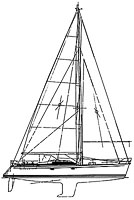Rutter 57
Cruising sloop performance cruiser
Most cruising boats grow from the inside out, and this boat was no exception. The layout features a comfortable owner's stateroom aft, with a double berth and adjacent head. There is a washer and dryer in the head. Stepping down into the galley the big, combined reefer and freezer is to port with huge pantry lockers over a second reefer-freezer at counter height. The galley to starboard has counter space on each side of the sinks and the range.
Forward of the galley is the combination workshop-forward stateroom, with a long workbench to starboard and copious lockers and drawers for tools and spare parts. To port there are upper and lower berths. Overhead is a large 30-by-30-inch hatch, which provides ventilation and makes it possible to move in tools and materials. If there is any feature that sets this design apart, it is the sheer number of drawers and lockers. Forward of a watertight bulkhead there is a large fo'c'sle for sail and scuba-gear stowage.
The raised saloon makes room in the bilge for tankage and the 88-horsepower Yanmar diesel. There are two fuel tanks for a total of 370 gallons of fuel, and two water tanks for a total of 300 gallons of water. There is 80 gallons of holding in two tanks located adjacent to the two heads.
This hull was designed for good all-around performance. Displacement is on the light side with a D/L of 103, calculated with tanks half filled. In my office we call these boats "cruising sleds" and have done several in this style. The forward sections are U-shaped, fairing into a midsection with 8.5 degrees of deadrise. This deadrise provides a natural sump area in the bilge and helps with longitudinal stiffness. There is a slight hollow to the waterline forward. The deadrise is carried aft to help prevent a counter that slaps at anchor.
The keel is a bulbed fin, and the rudder is a deep carbon fiber spade. The beauty of a carbon fiber rudder for a cruising boat is that the rudder and stock are essentially monocoque, indestructible and very light. By eliminating a skeg we give the rudder balance, take some of the load off the Edson steering gear and make a boat that backs up with predictability.
The sail-handling systems may be at the heart of the success of a cruising boat. Despite the removable inner forestay for a storm jib, I think the mast location qualifies this rig correctly as a sloop. The SA/D is 24, and that's pretty healthy for a cruising boat while it diminishes the need for overlapping headsails. We are using the Leisure Furl in-boom furling system for the mainsail. This is the slickest trick since self-tailing winches. I've specified the Leisure Furl three times. I love it. My wife loves it, and the owners love it. You get a normal main with draft, unlimited reefing increments, roach and, most importantly, battens. The mainsheet traveler is on the bridgedeck. Construction is composite with a Divinycell core, vinylester resin and unidirectional and bidirectional knitted E-glass fabrics. There is an 8-ounce layer of Kevlar on the outside for durability. The cruising sled must combine toughness in its laminate with panel stiffness. There is a full length topside hat-section stringer.
I hate to use the expression "serious cruising boat" but that's what this is. There was no attempt to maximize market appeal in this design. This is a boat for the Rutters.

Comments